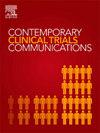C.E.R.E.B.R.O.: A home-based physical activity study for older Latino adults
IF 1.4
Q4 MEDICINE, RESEARCH & EXPERIMENTAL
引用次数: 0
Abstract
Background
The growing Latino population is 1.5 times more likely to develop Alzheimer's Disease (AD) and Related Dementias (ADRD) than non-Latino Whites. Interventions that can reduce the risk of ADRD are needed. Older Latinos face many barriers to the incorporation of physical activity (PA) into their daily lives given a lack social support, caregiving responsibilities, and lacking resources to maintain PA. Walking and dancing are the two most frequently reported forms of PA among older Latinos, and indoor PA programs conducted in a community location or at home can overcome barriers to participation.
Methods
C.E.R.E.B.R.O. (Cognitive Enhancement and Risk-reduction through Exercise for Brain-Related Outcomes; meaning “brain” in English) is testing two remote intervention programs, the BAILAMOS™ dance program and ¡En Forma y Fuerte! (Fit & Strong!), a PA/behavior change program. Participants are randomly assigned to either study condition. The BAILAMOS™ dance program is a 6-month long dance program, in which participants learn different Latin dances including Merengue, Cha Cha Cha, Bachata, Salsa, Cumbia, and Kizomba. Trained CEREBRO staff also lead monthly discussions. Persons randomized to the 3-month long ¡En Forma y Fuerte! program participate in flexibility and aerobic exercise, strength training, and health education. All classes are held live via Zoom. Trained study staff assist participants with technology-related issues. Data are collected through remote testing at baseline, 12 weeks, and 24 weeks after the start of the interventions. Outcomes include PA, cognition, quality of life, social connectedness, and cost-effectiveness.
Conclusion
CEREBRO has the potential to provide evidence regarding the advantages of providing remote intervention programs to reduce PA barriers in the older Latino community.
c.e.r.e.b.r.o.:一项针对拉丁裔老年人的家庭体育活动研究
不断增长的拉丁裔人口患阿尔茨海默病(AD)和相关痴呆(ADRD)的可能性是非拉丁裔白人的1.5倍。需要采取能够降低adr风险的干预措施。由于缺乏社会支持、照顾责任以及缺乏维持体育活动的资源,老年拉丁美洲人在将体育活动(PA)纳入日常生活方面面临许多障碍。步行和跳舞是老年拉丁美洲人中最常见的两种PA形式,在社区或家中进行的室内PA项目可以克服参与的障碍。通过锻炼对大脑相关结果的认知增强和风险降低;(意为“大脑”)正在测试两个远程干预程序:BAILAMOS™舞蹈程序和En Forma y Fuerte!(适合,Strong!),一个PA/行为改变计划。参与者被随机分配到两种研究条件中。BAILAMOS™舞蹈项目是一个为期6个月的舞蹈项目,参与者将学习不同的拉丁舞蹈,包括梅伦格舞、恰恰舞、巴恰塔舞、萨尔萨舞、Cumbia舞和Kizomba舞。训练有素的CEREBRO员工也领导每月的讨论。被随机分配到为期3个月的“Forma y Fuerte!”计划参加柔韧性和有氧运动、力量训练和健康教育。所有的课程都通过Zoom进行直播。训练有素的研究人员协助参与者解决与技术相关的问题。在干预开始后的基线、12周和24周,通过远程测试收集数据。结果包括PA、认知、生活质量、社会联系和成本效益。结论cerebro有潜力为提供远程干预方案的优势提供证据,以减少老年拉丁裔社区的PA障碍。
本文章由计算机程序翻译,如有差异,请以英文原文为准。
求助全文
约1分钟内获得全文
求助全文
来源期刊

Contemporary Clinical Trials Communications
Pharmacology, Toxicology and Pharmaceutics-Pharmacology
CiteScore
2.70
自引率
6.70%
发文量
146
审稿时长
20 weeks
期刊介绍:
Contemporary Clinical Trials Communications is an international peer reviewed open access journal that publishes articles pertaining to all aspects of clinical trials, including, but not limited to, design, conduct, analysis, regulation and ethics. Manuscripts submitted should appeal to a readership drawn from a wide range of disciplines including medicine, life science, pharmaceutical science, biostatistics, epidemiology, computer science, management science, behavioral science, and bioethics. Contemporary Clinical Trials Communications is unique in that it is outside the confines of disease specifications, and it strives to increase the transparency of medical research and reduce publication bias by publishing scientifically valid original research findings irrespective of their perceived importance, significance or impact. Both randomized and non-randomized trials are within the scope of the Journal. Some common topics include trial design rationale and methods, operational methodologies and challenges, and positive and negative trial results. In addition to original research, the Journal also welcomes other types of communications including, but are not limited to, methodology reviews, perspectives and discussions. Through timely dissemination of advances in clinical trials, the goal of Contemporary Clinical Trials Communications is to serve as a platform to enhance the communication and collaboration within the global clinical trials community that ultimately advances this field of research for the benefit of patients.
 求助内容:
求助内容: 应助结果提醒方式:
应助结果提醒方式:


